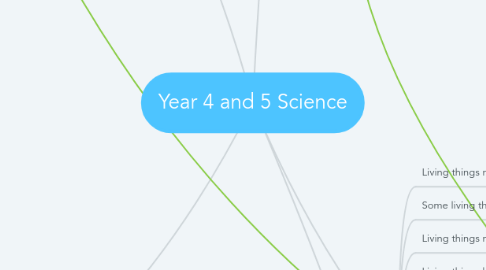
1. Outcomes Addressed
1.1. Science Inquiry Skills
1.1.1. With guidance, plan and conduct scientific investigations to find answers to questions, considering the safe use of appropriate materials and equipment
1.1.2. Use a range of methods to represent data
1.1.3. With guidance, identify questions in familiar contexts that can be investigated scientifically and make predictions based on prior knowledge. Pose clarifying questions.
1.1.4. Compare results with predictions, suggesting possible reasons for findings
1.1.5. Represent and communicate observations, ideas and findings using formal and informal representations
1.1.6. Decide variables to be changed and measured in fair tests, and observe, measure and record.
1.2. Science Understanding- Biological Sciences
1.2.1. Living Things have life cycles
1.2.1.1. making and recording observations of living things as they develop through their life cycles
1.2.1.2. Describing the stages of life cycles
1.2.1.3. comparing life cycles of animals and plants
1.2.2. Living things depend on each other and the environment to survive
1.2.2.1. investigating roles of living things in a habitat
1.2.2.2. observing and describing predator-prey relationships
1.2.2.3. predicting the effects when living things in feeding relationships are removed or die out in an area
1.2.3. Living things have structural features and adaptations that help them to survive in their environment
1.3. Science as a Human Endeavour
1.3.1. Science involves making predictions and describing patterns and relationships. Testing predictions by gathering data is an extension of this.
1.3.2. Science knowledge helps people to understand the effect of their actions, solve problems and inform decisions.
2. Knowledge after Teaching and Learning
2.1. Living things need to be kept safe
2.2. Some living things need sleep
2.3. Living things need a safe environment
2.4. Living things have ideal temperature for survival
2.5. Mealworms like to burrow
2.6. Mealworms eat carrots, leaves, fungi, cornmeal and oatmeal
2.7. Birds, echidnas, possums, mice, venus fly traps eat mealworms
2.8. Mealworms and other insects are in the same spot in the food web
2.9. Fungi don't eat, but absorb nutrients
2.10. Every living thing is important for our ecosystem
2.11. We have a reciprocal relationship with the ecosystem
2.12. Scientists predict, observe, and reflect
2.13. Scientific thinking can help us solve problems
2.14. Scientific thinking can help us understand the world
2.15. Different living things behave in different ways
2.16. Observations can be recorded in a variety of ways
2.17. It is important to record the same aspects each time to observe changes
2.18. Scientific observations must be objective
2.19. Scientists need to check that their sources are reliable
2.20. Scientists use peer reviewing to obtain more accurate results
2.21. Scientists share their knowledge with others
3. What Might Come Next
3.1. From here it would be fantastic to see the mealworms breed. This would mean the students could observe the entire life cycle.
3.2. The students will present their understandings, skills and knowledge in the form of a multimedia presentation.
3.3. It would be a great opportunity if the students could share their learning with their peers as they are very enthusiastic to tell others what they have learnt.
4. Prior Knowledge
4.1. Living things
4.1.1. are alive
4.1.2. need food and water
4.1.3. need to be clean
4.1.4. need to sleep
4.1.5. have hearts
4.1.6. 'pee and poo'- excrete waste
4.2. plants and animals are different on the inside
5. Teaching and Learning
5.1. Lesson 1
5.1.1. Identify features of living things
5.1.2. Identify key characteristics of animals' habitats
5.1.3. Identify what living things require to survive
5.2. Lesson 2
5.2.1. Identify features of habitats
5.2.2. Explain how animals have characteristics that enable them to survive in certain habitats
5.2.3. Make predictions on what will happen to the mealworms
5.2.4. Apply knowledge of habitats
5.2.5. Make and record observations
5.2.6. Decide on variables to change
5.2.7. Pose questions to investigate
5.3. Lesson 3
5.3.1. Where living things are in the food web
5.3.2. Understand the impact of removing a link from the food web
5.3.3. Make and record observations
5.3.4. Pose questions to investigate
5.3.5. Make predictions on what will happen to the mealworms
5.3.6. Understand the impact that we have on living things
5.3.7. Understand the impact that living things have on us
5.3.8. Investigating relationships between living things
5.3.9. Compare results with predictions
5.4. Lesson 4
5.4.1. Identify stages of a life cycle
5.4.2. Make comparisons between life cycles of living things
5.4.3. Utilise a range of sources to find information
5.4.4. Pose questions to investigate
5.4.5. Make predictions on what will happen to the mealworms
5.4.6. Compare results with predictions
5.5. Lesson 5
5.5.1. Identify stages of a life cycle
5.5.2. Make predictions on what will happen to the mealworms
5.5.3. Compare results with predictions
5.5.4. Explain features of each stage in the life cycle
5.5.5. Compare the mealworm life cycle to other living things
5.5.6. Present knowledge in multimodal forms
5.6. Lesson 6
5.6.1. Consider audience when creating an multimodal text
5.6.2. Identify stages of a life cycle
5.6.3. Explain features of each stage in the life cycle
5.6.4. Present knowledge in multimodal forms
5.6.5. Recall and explain prior knowledge
